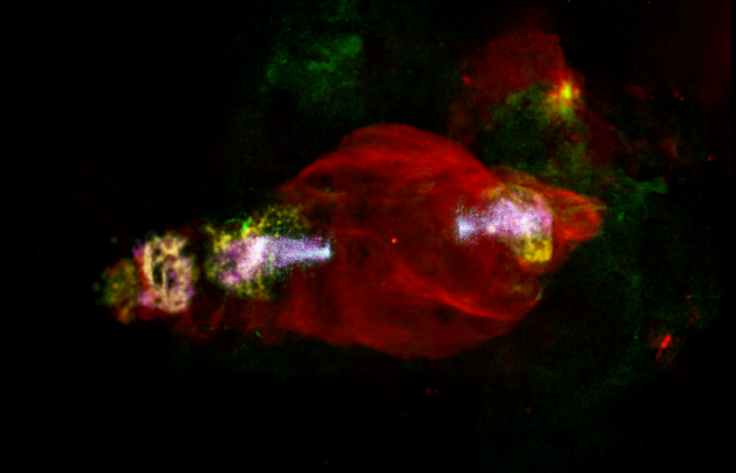Reviewed by Alex SmithJul 6 2022
A global team of astrophysicists has located the area in space that is shaped like a “Manatee,” a gigantic aquatic creature, from which strong, extremely energetic X-Rays are being emitted into space.
 The “Manatee.” Red is radio (VLA, G. Dubner et al), green is optical (Skinakas Observatory in Greece, P. Boumis et al.), yellow: soft x-rays (0.5–1 keV), magenta: medium energy x-rays (1–2 keV), cyan: hard x-ray emission (2–12 keV) using ESA’s XMM-Newton. Image Credits: Samar Safi-Harb et al. (2022)
The “Manatee.” Red is radio (VLA, G. Dubner et al), green is optical (Skinakas Observatory in Greece, P. Boumis et al.), yellow: soft x-rays (0.5–1 keV), magenta: medium energy x-rays (1–2 keV), cyan: hard x-ray emission (2–12 keV) using ESA’s XMM-Newton. Image Credits: Samar Safi-Harb et al. (2022)
They discovered that the object’s spectrum indicates the existence of a “non-classical acceleration process” in which particles are being injected and then re-accelerated in exceptionally powerful jets of energy released by a black hole.
However, since it is more than 100,000,000,000,000,000 km away from us, there is no need to be concerned about it irradiating us.
Widely known to contain a black hole that spews energy out in jets of very violent particles throughout the Milky Way, SS 433 is an astronomical entity. It is located in the center of the remnants of an exploded star in the constellation Aquila, high in the summer night sky, and is regarded as the first known microquasar.
This fascinating system looks like a beautiful Manatee in space and represents the only known supernova remnant in our Galaxy (out of some 400 such objects) housing a black hole.
Dr. Samar Safi-Harb, Study Lead Author and Astrophysicist, University of Manitoba
Graduate student and UM team member Brydyn Mac Intyre contributed to the creation of a stunning color image of this extraordinary celestial phenomenon. Two “earlobes” that shine at radio frequencies and were cut by jets traveling across space at a quarter of the speed of light are where the energy bursts come to an end.
The space along the jets path glows brilliantly in high energy x-ray and gamma-ray light tens of light-years away from the black hole, but not visible to the naked eye.
Brydyn Mac Intyre, Graduate Student and Team Member, University of Manitoba
Astrophysicists have been looking for high-energy gamma-ray radiation from the region as SS 433 is really strong. The system accelerates particles to energy higher than those possible in the most potent particle accelerators on Earth, according to a hypothesis made by Safi-Harb in the late 1990s.
Nearly 20 years passed before high-energy gamma rays were found; in 2018, researchers at the High-Altitude Water Cherenkov Observatory reported the finding of high-energy TeV (Tera-electron-volts) gamma rays from the system. However, until today, it was impossible to identify the location of particle acceleration.
This team of researchers was able to identify the location of the “hardest” (or highest energy) X-Ray emitting region near SS 433, which is thought to be the beginning of the eastern jet emission on large scales, using data from NASA’s Chandra X-Ray telescope, the European Space Agency’s XMM-Newton satellite, and NASA’s NuSTAR satellite, modern orbiting X-Ray telescopes.
This potent energy source, which is now thought to accelerate particles to very high energies, is a strong candidate for a cosmic “PeVatron,” a source that is accelerating cosmic rays up to Peta-electron volt energies, or 1,000,000,000,000,000 V, according to Dr. Kaya Mori, a collaborator and astrophysicist from Columbia University in New York.
Safi-Harb added, “Given the unusual nature of the spectrum and source location, this discovery challenges the theory of particle acceleration and points to injection and re-energization of the SS 433 jets at large distances, nearly 100 light-years away from the black hole.”
“SS 433 teaches us about, and zooms-in on, the rare case of a supernova remnant powered by a black hole, microquasars, ultra-luminous X-ray sources (a growing class of X-ray emitting sources whose nature is being debated) and is a micro-version of an active galaxy!,” further added Safi-Harb.
Many undergraduates from the University of Manitoba and Columbia University participated in this study, including Matthew Band, an undergraduate summer research awardee from the Price Faculty of Engineering at the University of Manitoba, who is a co-author of the publication.
I didn’t expect my summer work to be a part of something like this, I am thrilled. It is an honor to learn from such great people and be a member of this international collaboration.
Matthew Band, Study Co-Author and Undergraduate Summer Research Awardee, Price Faculty of Engineering, University of Manitoba
In a study accepted for publication in the Astrophysical Journal, the researchers revealed their discovery. This article will soon be presented at the International Symposium on High-Energy Gamma-Ray Astronomy in Barcelona.
Journal Reference:
Safi-Harb, S., et al. (2022) Hard X-ray emission from the eastern jet of SS 433 powering the W50 ‘Manatee’ nebula: Evidence for particle re-acceleration. Astrophysical Journal. arXiv:2207.00573v1.